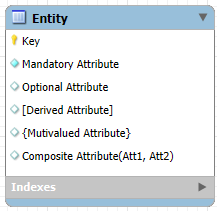A way of describing a entity-relationship diagram that is used in the logical database design and physical database design stage.
Entities
All entities and relationships (with attributes) are represented as boxes

Attributes
Added into an entity
| Attribute Type | Icon |
|---|---|
| Mandatory (NOT NULL) | Blue Diamond |
| Optional | Empty Diamond |
| Derived | Surrounded with [] |
| Multivalued | Surrounded with {} |
| Composite | Each subattribute is inside a () |
| Key | Lightbulb |

Derived Attributes only exist up to the Logical Database Design stage
They disappear in the physical database design stage, as they can be calculated from other attributes and do not need to be represented directly.
Relationships
All relationships that do not contain attributes in Crow’s Foot Notation are represented directly using links.
Else, each relationship is represented as an entity, like in the relational data model
| Relationship Type | Notation |
|---|---|
| Default | Associations have dashed lines |
| Identifiying | Associations have solid lines |
| Unary | Associations point back to the entity |
 |
Associations
Crow's foot notation work's opposite to Chen's Notation
Unlike Chen’s Notation, crow’s foot applies it’s restrictions to the entity away from the symbols.
| Association Type | Notation | Cardinality (On the opposite entity) |
|---|---|---|
| Default (Optional + Many) | ||
| Key Constraint (Optional One) | ||
| Total Participation Constraint (Mandatory Many) | ||
| Total + Key Constrain (Mandatory One) |
Examples
Weak Entity
Remember that a weak entity is one that can only be uniquely reference using it’s parent entity:
- The weak entity has a key constraint and a total participation constraint
- The relationship is known as identifying
We can use crow’s foot notation to describe a weak entity as such:

Notice how the key constraint and participation constraint (the double lines) are away from the Weak Entity (closer to the Strong Entity).